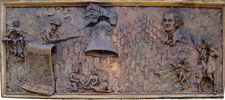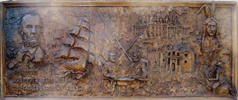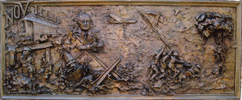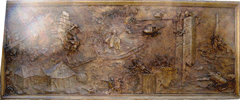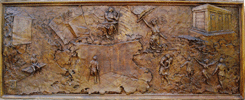All Wars Memorial History
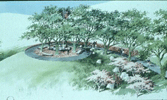
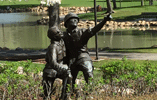
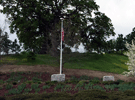

The AWM originated in concept and design with the Viet Nam Veterans of Diablo Valley (VNVDV) - this was their first major project in 1995 - along with the initial fundraising for just over ten years. This fundraising basically allowed the VNVDV to pay for the statue at the Memorial. The VNVDV had an AWM committee which reported at every meeting. Fundraising as a single Veterans Service Organization (VSO) was difficult and design costs for the memorial and statue were expensive. It was decided to form a joint outside committee including others in the community who knew about fund raising with VNVDV members - and so was formed the AWM Foundation with a wide variety of Board Members. The VNVDV President has a "rotating position" on the AWMF Board - as does the President of the Blue Star Moms. These are the only two VSOs officially represented; however many on the Board are members of the Legion, VFW, VNVDV, MCL & other VSOs. The Board has always had a local government representative - in the beginning they had representatives from both San Ramon and Danville. Mike Shimansky was the key person who got the Danville Town Council to vote to allow the land to be used to construct a war memorial and he served on the Board until his death.
The Liberty Panels
One area regarding the various wars are "The Liberty Panels" - these bronze displays are used by teachers in the Tri-Valley community for various study projects and are another key feature of the memorial, along with the freedom wall & Lincoln quotes.
Panel 1 - The Birth of the Republic
The panel opens with a group of patriots throwing tea casks into Boston harbor to protest British “taxation without representation”. Paul Revere rides out to warn of British troops marching to capture the Minutemen’s arsenal. The figure of George Washington overlooks the scene. The Liberty Bell is in the center with its inscription to “proclaim liberty throughout all the land”. A Continental Army soldier seems to stand guard over an injured comrade having his wounds dressed by two women patriots and the scroll of the Declaration of Independence with its timeless and revolutionary statement that “all men are created equal”. Betsy Ross sewing the thirteen stars and stripes banner completes the panel of the American War for Independence.
Panel 2 - With malice toward none; with charity for all
The United States’ first international test comes during the British attempt to conquer the new nation during the War of 1812. That conflict is represented by the burning of the White House (then called the Executive Mansion) by the British and the USS Constitution “Old Ironsides” under full sail. The Alamo is below the White House. Sitting Bull and a mounted cavalry trooper represent the wars in the American west. The Civil War determines whether the young nation will survive a movement to split it into factions. The figure of Abraham Lincoln is at the left. He defines the conflict as a battle to preserve the Union. His speech at the dedication of the cemetery at Gettysburg begins with the quotation below and ends with asking whether government “of the people, by the people and for the people” can survive. Generals Lee and Grant are sitting at the table in the center signing a surrender document which will help heal the nation.
Panel 3 - The Arsenal of Democracy
The bottom left of the panel shows a World War I American “doughboy” and his mule prepared for one of the horrors of trench warfare- a gas attack. Above them is the railcar in which the armistice was signed bringing the hostilities to an end on “the eleventh hour of the eleventh day of the eleventh month” (November 11, 1918). November 11 is known as Armistice Day in many countries and became Veteran’s Day in the United States in 1954. Franklin Roosevelt speaks to the country in one of his radio broadcasts known as “fireside chats”. His calm assuring voice carried the American people through the Great Depression and World War II. Below FDR is the wreckage of “battleship row” during the attack on Pearl Harbor ushering the United States into World War II. Carrying the war to the enemy are American GIs struggling ashore on the northern coast of France on D-Day, a US bomber on its bombing run and the raising of the American flag on Iwo Jima by US Marines. The mushroom cloud of an atomic blast ends the war and completes this panel.
Panel 4 - Ask not what your country can do for you - ask what you can do for your country
Children stand on rubble in postwar Berlin waving at the airplanes airlifting vital supplies after Communist forces isolated and attempted to starve the city. The Berlin Wall is being torn down by happy Berliners just to the right of the airlift planes.
A mobile army surgical hospital (MASH) tent and helicopter represent the Korean War to free South Korea from the Communist invasion. American GIs struggle through the swamps of Southeast Asia as Huey helicopters drop in to pick them up after a mission. The War on Terror is represented by the attack on the World Trade Center towers and two soldiers pulling down Saddam Hussein’s statue during the Iraq War. A Polaris submarine and missile remind us of the need to be ever vigilant.
Panel 5 - The Last Full Measure of Devotion
The final plaque depicts images of sacrifice. To the left hangs a “blue star” flag denoting someone in the family in the service of their country. Below the flag sits a prisoner of war and a POW/MIA flag with the banner “you are not forgotten” is in the lower corner. A Western Union telegram brings the dreaded news that “we regret to inform you”. A “Rosie the Riveter” and the image of Liberty Triumphant are top center while a Vietnam Veteran missing a leg scans the Vietnam Veteran’s Memorial wall for a buddy’s name. A note at the base of the wall says “Dad, I Miss You” to a long lost father. The right side shows two joyous homecomings. The “Tomb of the Unknowns” at Arlington National Cemetery with its inscription “Here Rests In Honored Glory An American Soldier Known Only To God” completes the panel.

